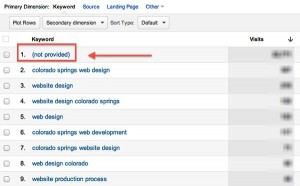 In an effort to secure more privacy for its users, Google has implemented “secure search”. However, this security has caused some major disruptions for SEO agencies. For most of you who don’t know where to find the “(not provided)” data, it lays in the terms of a user’s application in organic keywords. The SEO agency now has to identify exactly what the customer was searching for and how he landed on the specific site. SEO agency’s do not look forward to tracking the organic keywords from Google referrals anymore because it’s “(not provided)”.
In an effort to secure more privacy for its users, Google has implemented “secure search”. However, this security has caused some major disruptions for SEO agencies. For most of you who don’t know where to find the “(not provided)” data, it lays in the terms of a user’s application in organic keywords. The SEO agency now has to identify exactly what the customer was searching for and how he landed on the specific site. SEO agency’s do not look forward to tracking the organic keywords from Google referrals anymore because it’s “(not provided)”.
September 23 made a crashing sound to all the websites who still did not have any significant issues with their keywords, but then many sites were seeing more than “50 percent” as “(not provided)”. While the move from Google was imminent, 95+ keywords not being reported with 5 percent of non-Google searches were certainly a nightmare for the keyword hunters:
While there is still a possibility that after some time, Google might introduce a new release of “premium” version of Google Analytics where users are obliged to pay a monthly fee in order to gain access to full keyword data. But meanwhile for SEO professionals out there, the question lies in generating that same rank in the traffic. Although Google isn’t providing any replacements, here are some important ways you can look at to replace the “(Not provided)” data.
When looking for an alternate way to get to that explicit keywords that the searcher used, there are lots of Analysis that has been completed on this concept, like the one from Avinash Kaushik, a top analytical expert who blog posted a “smarter data analysis” explaining the SEO’s about what they can do with their Google Analytics account to face the “(Not provided)” issue. Searching for non-Google keywords and using Google Webmasters tools can help a lot in determining the keywords that are dominating the market and the queries related to data encryption searches. Why not use the alternatives which are provided by Google instead of waiting for the imminent changes which is uncertain.
I recall using Google Adwords for a certain period of time and it proved quite useful and it still is. You should also analyze on-site searches that are taking place inside your website. These types of small steps ensure that you determine the value of high traffic keywords and their exact use in the most organic way possible. I know it is not accommodating when you are seeing a 97% “ not provided” rates, but you can still utilize the data to set up filters for all your “not provided” traffic which will at least illustrate you what the user was searching for on the site.
Data history is always important especially when it comes to checking seasonal content. For example, you will want to check last summer to this summer to identify if your strategy preformed well or if you need to make adjustments. Google trend is also a good alternative for checking the reasons why your web page has been garnering huge publicity recently and also check the specific trends that are prevailing in the market.
If you have any questions about “not provided” data by Google, please contact WebitMD here.


(1).jpg)


.jpg)




![5 Reports to Elevate Your HubSpot Sales Dashboard [+ Examples]](https://2363531.fs1.hubspotusercontent-na1.net/hub/2363531/hubfs/Imported_Blog_Media/6-winning-examples-of-a-hubspot-sales-dashboard-2.png?width=767&name=6-winning-examples-of-a-hubspot-sales-dashboard-2.png)

